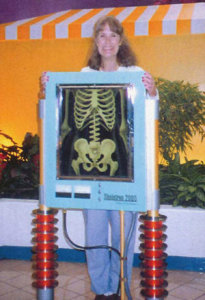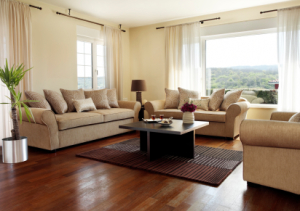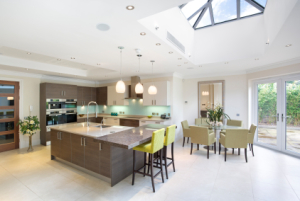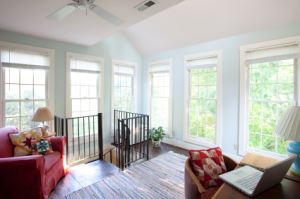Home Lighting
 The benefits of using our greatest—and most sustainable—light source: the sun.
The benefits of using our greatest—and most sustainable—light source: the sun.
Q. Can you explain what daylighting is and why it’s important to building design?
A. Daylighting refers to the utilization of direct and reflected sunlight to illuminate building interiors. Properly managed, it can reduce the need for electric lighting. Poorly managed, it can cost more in electricity for lighting and air-conditioning. The fenestrations—windows, glass doors, and skylights—allow light to enter the interior. The orientation of the fenestrations—north, south, east, and west—determine when the light will enter and how deeply it will penetrate the interior. These are important considerations for designing a successful building, not only for the energy-efficiency, but also for the occupants. Well-managed daylighting reduces electricity consumption and is enjoyed by the buildings’ occupants. It can also provide LEED points for the building. Daylight harvesting is used in commercial spaces to reduce electric lighting when sufficient daylight is available to accomplish the required visual tasks. The amount of required light is preset and when a photo sensor determines that the daylight is sufficient, either the electric lights get dimmed or some light sources get turned off. When the daylight is insufficient, the electric lights are either brightened or turned on. Either way, daylight is essentially utilized or harvested.
Q. What is the difference between active daylighting and passive daylighting?
A. The difference is tracking the sun versus not tracking the sun. Active daylighting utilizes equipment that can move to capture the sunlight whatever direction it comes from. Passive daylighting utilizes the buildings’ windows, glass doors, and glass on the roof through which sunlight enters when it is in line with the glass or other transparent openings. Active daylighting is successful and passive daylighting can be also, if well planned.
 Q. How can daylighting and passive-solar design work in conjunction with one another to reduce energy costs?
Q. How can daylighting and passive-solar design work in conjunction with one another to reduce energy costs?
A. By positioning the building’s fenestrations—windows, glass doors, and skylights—to receive direct, warm sunlight to heat interior spaces and/or interior heat-absorbing materials on the floor or in the walls. Typically, south-facing fenestrations work best. In addition, designers can position visual task locations away from direct sunlight, as it is typically too bright and can be hot. Other architectural techniques can be used to cool the sun’s heat-gathering spaces during warm weather, like the Venturi Effect, which is facing a small opening toward a cool, incoming breeze and having a large opening in the opposite direction to let the hot air out fast. Venturi was an 18th-century physicist who observed this effect with fluid. 
Q. For homeowners who are building new, what are some ways daylighting can be integrated into the design of their home?
A. Develop your floor plan with respect to when the rooms would be used. Do you like sunlight during breakfast in the mornings? Do you want reflected daylight at dinner time? Do you want morning sunlight in your bedroom? Do you want midday light in the family room? Do you want a high-quality, dark, projector-based, home theater without windows? Do you want your art studio to have only northern reflected light? Do you want your patio out of the sunlight? These considerations, and many more, can be successfully obtained with careful architectural planning. (More information can be found in my book Energy-Efficient Daylighting and Electric Lighting Techniques, available through IES.org.)
Q. For homeowners who are renovating an existing home, what are some cost-effective daylighting strategies/systems they could implement?
A. There are both interior and exterior strategies, depending on whether you need to avoid direct sunlight or capture daylight. To avoid direct sunlight, interior strategies can include furniture arrangements, window coverings, and interior finish choices. Exterior strategies can be architectural and/or landscape. Multiple strategies work well for around-the-clock effects. To capture daylight, the cause must be identified and a cure determined to correct the cause. Is it a cloudy climate? Are there too few or too small places for daylight to enter? Are trees or shrubbery blocking the light? Are other buildings casting a shadow? Is the sunlight on the other side of the house and not in the room where you want it? The cure is likely to be a single strategy. The cures can be internal and/or external to the house. 
Q. How about clerestory windows, light shelves, and light tubes? When would you recommend those in a home?
A. Clerestory windows are fenestrations above eye level. They are excellent for bringing in and spreading sunlight to a room, and could be added to existing rooms in certain circumstances. Light shelves are an architectural element parallel to the floor, mounted above eye level to reflect sunlight to the ceiling, typically through clerestory windows. The shelf can be inside, outside, or both, depending upon the geometry of the sunlight entering the window. Light shelves look best on contemporary-style buildings, and would not be suitable for period-style architecture. Light tubes are basically tunnels from a transparent place on the roof down through the attic into the ceiling of a room, bringing in daylight. Some of the more sophisticated ones can be dimmed and also can have electric lights. Light tubes are a good solution for dark rooms when the ceiling has easy access to the roof.
Lighting designer and author Jane Grosslight has written three books and six booklets on lighting. The books were recognized with a Progress Award by the Illuminating Engineering Society (IES) for their advancement of the art and science of lighting. More in-depth details on daylighting can be found in her book Energy-Efficient Daylighting and Electric Lighting Techniques, available through the IES bookstore at www.ies.org. Details on retrofitting energy-inefficient light sources are available in her book Money in Your Pocket with a Bulb and a Socket for Homes and Businesses, also available through IES.org. In addition, six other publications on lighting are featured on her website: www.durwoodpublishers.com.